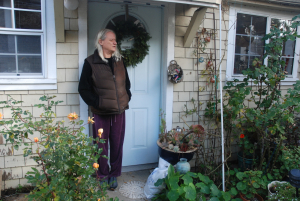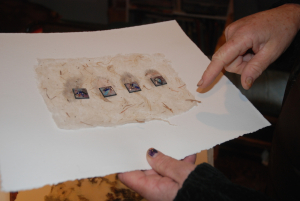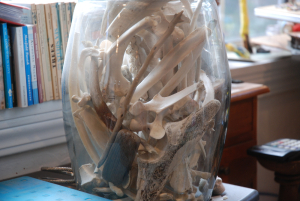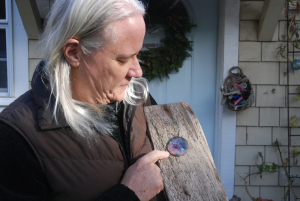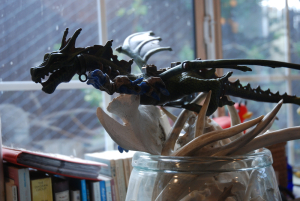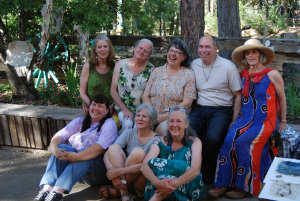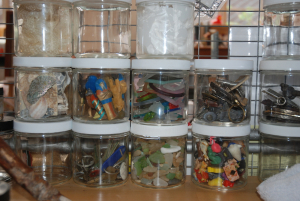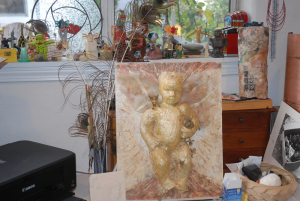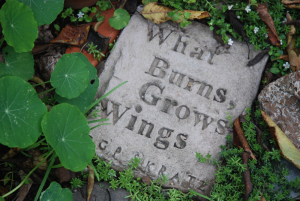A Conversation with Artist Linda Lemon, Paper Maker and Mixed Media Instructor
“People long to be recognized, they want to be invited out to play. I’ve seen it change people’s lives – this jolt of pure inspiration. You are changed, something is unlocked, and you can never go back.”
Interview with Ramona d’Viola and Karen LeGault
A lifelong artist, Linda Lemon never considered teaching art as a vocation, however, after her son passed away, she found her world spiraling downwards. It was at this time she happened to run into Karen LeGault who suggested she might benefit from sharing her skills as a teacher in afterschool art programs, or at the Feather River Art Camp.
Teaching turned out to be the perfect medicine for a broken heart and a pathway towards healing.
“I had never thought about teaching, and I never intended to become a teacher,” says Lemon. “Karen was very instrumental in steering me towards exploring this possibility.”
Lemon claims that she can’t draw or paint, but if should could, she would have become a painter. But this “limitation” caused her to gravitate towards alternative outlets for her creativity.
“My medium has always been paper,” says Lemon. “Papermaking is an ancient art – still done the way the Chinese did it, because there is no other, or better, way. It’s very sensual. People don’t have much of an opportunity to work with their hands.
“One of the things I love about paper is that it’s inherently spiritual. Paper can be made from all kinds of things – tree bark, branches, flowers or plants. You’re working directly with spirit when you work with paper,” she adds. “It invites you to bring your own spirit out as you collaborate with nature.”
Over the years, Lemon’s fascination with “junk” has influenced the course of her paper making process. She now regularly includes found objects that add a unique beauty to her pieces.
“In my evolving artistic exploration and expansion, I started combining handmade paper with other items – junk, banged up stuff, driftwood – anything that captured my attention. I enjoy watching the way a piece transforms during development – taking on a life of its own.”
As her own work evolved, so did her teaching process. When Lemon first began teaching at Feather River Art Camp, her approach placed a strong emphasis on the foundation of papermaking.
“Because I was new to teaching, I thought it best to provide the basics in a structured environment, with each class looking at a different aspect of paper making,” says Lemon. “Day 1 – pulp prep, day 2 – fiber gathering, day 3 – adding color and dyes, day 4 – controlling shapes, day 5 – finished product.
“Now, I introduce my students to the paper making essentials in the first day of class, then it’s up to them to pursue what they’re interested in,” says Lemon. “In the last few years, I’ve been amazed at how little I’m actually teaching. My role is more of a ‘consultant.’ I hold a space for them to explore their creativity while they work on their pieces.
“It’s intriguing and fascinating to watch how the creativity unfolds.” adds Lemon. “I truly enjoy watching people in their creative process. The wonderful part of papermaking is its endless variations.”
Last year, Lemon became incapacitated after losing the use of one of her legs while at art camp. This physical limitation yielded unexpected results. She found by simply “holding the space” allowed her students the freedom to improvise. It also created a catalyst for them to bond and become mentors to each other.
“The group consciousness shifted from a hierarchy, to synarchy, where everyone is equal,” says Lemon. “The values within the group were different. It was fascinating to see the evolution of this gathering of artists – a different springboard for creating – and for my own teaching.
“One of the beautiful things I observed was how my physical limitations liberated the students in ways that wouldn’t have occurred had I been ‘able-bodied’,” adds Lemon. “The group coalesced for inspiration, sparking the joy of spiritual collaboration – not direct collaboration – but more in the form of supportive collaboration. My students surprised me, and themselves. For some, this art camp is the only time they give themselves permission to create.
“Big leaps in my creativity tend to coincide with my emotional difficulties,” says Lemon. “When my son died my work changed. I began collaging maps and other materials, such as processed fibers that had not become pulp. I also started varnishing my completed pieces, no longer placing them behind glass, thus removing the barrier between art and viewer.
“That period of my life impacted and influenced my work. My limitations led to great expansion.”
Years later while undergoing chemotherapy for Hepatitis C, Lemon sequestered herself in her studio and began to experiment with encaustic, a medium containing beeswax, damar varnish crystals and pigment, which permeates paper when melted.
“When I first heard of encaustic, I knew I was interested, but it took years for me to embrace it. I loved the way the wax changed the paper – two natural items, beeswax, and paper,” says Lemon. “Working in seclusion, I completed a visual expression of my experience in the form of 36, 6” x 6” panels.”
Working with children has also changed Lemon’s approach – and appreciation of teaching.
“Kids are wide open, they unconsciously give themselves permission to do what ever,” says Lemon. “I do a lot of work with kids and I like how they play. Creating artwork is an advanced form of play. I like watching what they do because they get so excited. They can’t believe that they’re actually making something so beautiful!
“Teaching is different with kids. When I sit down with a child – there’s a look in their eyes, it’s a wonderful thing. I can feel them changing as they create, It’s perceptible,” says Lemon. “They get hit by inspiration; same thing for the adults. What’s exciting for kids, is inspiration for adults.
“One of the things I strive to do with all my students is to pay attention to them, listen to what they have to say, perceive them as they truly are. People long to be recognized,” says Lemon. “They want to be invited out to play. I’ve seen it change people’s lives – this jolt of pure inspiration. You are changed, something is unlocked, and you can never go back.”

